5 Different Types of Cots

Ready to buy your baby their cot? While they may all serve the same function, there are several different types of cots available on the market, which has been a wonderful way of ensuring that parents can choose the right cot for their little one. On the other hand, the multitude of options for cots has also made it difficult for parents to choose which cot they want for their kids.
While this decision doesn’t have to be one that you have to spend too much time fretting about, it’s understandable to want the best for your newborn. That’s why we’ve gone ahead to give you a description of the different cot options available so you can make an educated decision.
Why is it important to choose the right cot?
While babies will eventually learn to sleep in whatever cot you give them, sleep isn’t the only concern when buying a cot. Cots should provide a safe place for your baby to sleep – safe being the key word here.
1. To help prevent SIDS
Sudden infant death syndrome (SIDS) has taken many little ones away from their parents prematurely. Unfortunately, in many cases, SIDS has occurred when the babies were in a cot. This could have happened because the cot was too large and the mattress doesn’t fit it well, which caused them to roll into a gap and suffocate. Another reason is that the cot had moveable sides and collapsed and hurt the baby.
Thankfully, cot manufacturers have gone to great lengths to avoid these accidents, and while the risks have been minimised, they are still present.
2. To ensure optimal growth and development
Cots, and their mattresses, also have a significant influence over how your baby grows. For example, if a mattress is too soft or second-hand, your baby could lay in a way that obscures the way their spine or bones develop.
3. For convenience
Cots are also there to help you interact with your child. If you have a relatively small stature, it doesn’t make sense to buy a cot with ridiculously high sides because you won’t be able to reach for your child. So, buying the right cot also makes things more convenient for you.
To sum up, what we’re saying here, it’s important to choose the right cot in regards to keeping your baby safe, allowing them to grow and develop correctly, and making it easier for you to interact with them.
What are the different types of cots to choose from?
Without further adieu, here are the different types of cots that you can choose from:
A traditional cot
If you are a fan of the classics, then the traditional cot is the perfect option for you. It is a classic cot that has been used by parents for generations. The traditional cot features a rectangular shape with a frame often made of wood, plastic, metal, or composite materials. Generally, a traditional cot would be a fixed structure, meaning that it’s too heavy to move and that it has no moveable parts like other cots.
The cot has a barrier on all four sides, either open with bars to stop your baby from falling through the gaps, or with a fabric barrier to allow for sufficient airflow. Many parents like traditional cots because of the classic aesthetic they provide for the nursery. The fact that it’s a fixed structure is also beneficial as moveable parts tend to wear over time, presenting a progressive SIDS risk eventually.
It may be fun to add a baby mobile for cot to create a fun and cozy environment for baby.
A camp cot
A camp cot is meant to be a portable solution to a cot. It’s designed to fold up easily and pack away so that it can be used anywhere at any time. Generally, like a tent, a camp cot will have certain parts that are solid, usually to provide a sturdy frame, and then the rest of the cot will be made of strong, breathable fabric. You can get them in all shapes and sizes, but in most cases, they’re slightly smaller than a traditional cot. One caution that we’d make concerning camp cots is that they require you to assemble them correctly. If not, the fabric could collapse onto your child, posing a SIDS risk.
A co-sleeper
In the first three to six months of parenting, either the month or the father will be waking up every three hours to comfort your newborn. While training your child to be in their own room from the start will have its benefits later on, this can be incredibly difficult and risky if their room is far from yours. That’s why the co-sleeper was created.
The co-sleeper does exactly what its name suggests: it allows you to co-sleep with your child. Most co-sleepers have a removable side and adjustable height, allowing them to fit snugly to the side of your bed. When your baby wakes up at night, all you need to do is turn over to tend to them.
Unfortunately, co-sleepers seem to have a higher risk of SIDs, especially since a seam is often created between the co-sleeper and parents' bed, which they can slip into.
A bassinet
A bassinet is generally considered a better alternative to the co-sleeper. They’re very similar in the fact that they’re generally light and portable; however, they have four sides and don’t attach to your bed. So, you’ll have the convenience of having your baby in your room with you, but there will be a barrier to leaning over to engage with them.
What’s great about bassinets, too, is that they often come in pram form, allowing you to take them with you anywhere. However, bassinets are a temporary solution. They are usually smaller than a traditional cot and have a weight limit, so they'll be great for your child in their newborn phase.
A Moses basket
Most of us have heard the famed story of Moses, being sent down the river by his mother in a woven basket to save his life from the pharaoh. Well, his story still inspires cot designs today. Moses baskets are generally smaller than a traditional cot. They have an oval shape and are made with rattan woven material. They also have a hood sometimes. These baskets are a pretty safe solution for young babies but aren't really suitable for older babies.
Final Thoughts
Choosing a cot can be difficult, especially if you don’t know what type would best suit your baby. Generally, the best way to choose the right cot is to do side by side comparisons of different cots, measuring their features and prices against each other and your expectations. We wish you all the best, and congratulations!






